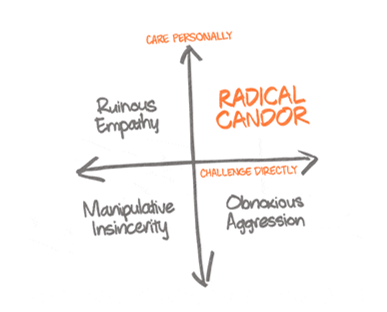Building your Inclusion Toolbox: Radical Candor
Originally posted: December 13, 2019
As many of you may know, I come to community-building via my experiences and training in conflict transformation and inclusive process design. This lens influences the way I assess and analyze new concepts and insights. I had the chance to read Radical Candor, by Kim Scott, earlier this year, and wanted to share some of the insights I gained from this book because I believe that the competency that Scott talks about in this book is part of what it takes to build more inclusive teams and workplaces. And teams with this competency can also realize productive outcomes from conflict, regardless of how polarized or how different positions or interests might be.
High level, this book, invites us to challenge directly and care personally in our work spaces.
“Create a culture of feedback, build a cohesive team and achieve great results. Radical Candor helps you love your work and the people you work with.”
An article in The Globe and Mail pegged the cost of workplace conflict (or unresolved conflict) at a whopping $16.1 billion in 2012 (Conference Board of Canada). Managing conflict productively is not only a key leadership competency, if done well, it’s a competitive edge that enables innovation, integration of diverse lenses and ideas ,superior decision-making, and higher performing teams. So many of us would rather suppress conflict at work rather than to address it because of the fear of negative consequences.
This book offers insight into how to create workplace cultures that can better handle conflict as it arises, and even prevent or de-escalate conflict. Giving thoughtful, authentic, and meaningful feedback is an investment that leadership and management can and must make in all of their staff. Scott offers insightful narratives, especially those that touch on cross-cultural differences in communication, the need to temper your message based on context. Scott draws on experiences at highly-performing companies like Google and AdSense, as well as concrete examples on how to best action the learning, with Part II of the book completely dedicated to Tools and Techniques.
Scott’s framework identifies three additional quadrants in which workplace feedback can fall:
Obnoxious Aggression™ is what happens when you challenge but don’t care. It’s praise that doesn’t feel sincere or criticism that isn’t delivered kindly.
Ruinous Empathy™ is what happens when you care but don’t challenge. It’s praise that isn’t specific enough to help the person understand what was good or criticism that is sugar-coated and unclear.
Manipulative Insincerity™ is what happens when you neither care nor challenge. It’s praise that is non-specific and insincere or criticism that is neither clear nor kind.
Radical Candor™ builds trust and opens the door for the kind of communication that helps you achieve the results you’re aiming for. It turns out that when people trust you and believe you care about them, they are much more likely to:
Accept and act on your praise & criticism;
Tell you what they really think about what you are doing well and, more importantly, not doing so well;
Engage in this same behaviour with one another; meaning less pushing the rock uphill again and again;
Embrace their role on the team;
Focus on getting results.
I worked on a team once where we had an informal philosophy that we called “Short Toes” that reminds me of radical candor; short toes meant that we could all speak our authentic truths, with respect to any aspect of the operations or performance of our organization, regardless of our position, and none of us would get offended or upset because we all operated from a place of wanting what was best for our organization. This freed us up to leave our egos at the door, and to truly focus on moving forward. This enabled a highly entrepreneurial culture, in my view, that allowed us to be responsive and to stay true to our purpose and our goals.
I wanted to share three great insights, rooted in what I see as the lens of conflict transformation, that if integrated into our leadership practice, can position us for more positive conflict experiences.
1. Relationships, not power, drive progress.
Investing more energy, at the beginning of any relationship, to authentically connect with each of your team members is key to creating conditions that allow us to have more productive and authentic conversations, even if the topic or decision is difficult. Especially if you are leading people, emotional labour, or listening, is a big part of your role. Inclusive and high trust teams can create a culture of guidance (that allows for praise and criticism) and allows us to understand what motivates each person on the team well enough to avoid burnout or boredom and keep the team cohesive, and drive results collaboratively.
2. Authenticity please.
Radical candor is not about schmoozing or being fake or exploitative. It’s about bringing all of yourself to the table. And moving with enough humility and curiousity in your space so that others can feel comfortable bringing all of themselves to work. The concept of radical candor actually flies in the face of being “professional: or repressed at work; it’s about bringing your humanity, your biggest asset, to work. Anyone can try to apply the advice and suggestions in this book. Scott actually cautions against this because it won’t work if these practices are not authentic to who you are. Reflecting on the principles in this book can allow us to generally shift our leadership style to include more of the tools that create radical candor workplace cultures.
3. Empathy has a shadow side.
This wasn’t an easy one for me to absorb, as a deep empath, and it makes so much sense when you think about it objectively. Kim Scott talks about “Ruinous Empathy”; what happens when you care too much and worry too much about hurting your colleague/report’s feelings. Scott leads with a story in the book about an employee she managed once, named Bob; she knew his work was terrible and Bob knew he did terrible work, and because she feared hurting his feelings, she failed to address the issue, and in fact, gave false praise. Ultimately, she did Bob, and the team a disservice by failing to address the issue upfront. Finding that fine balance between empathy and the commitment to truly constructive feedback is what builds stronger tand more inclusive teams.
Kim Scott also hosts a podcast that you can listen to, and a blog you can follow to learn more about “Radical Candor”.


